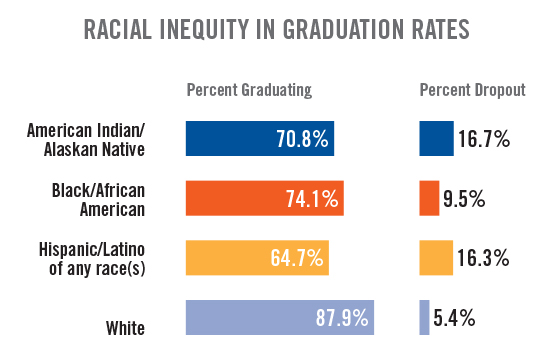Why do Students of Color Drop Out More Than Their Peers?
For an area that has just 47% white students in public school each year, it’s likely that graduation ceremonies this month won’t quite feel that way. The non-completion rates for students of color in Seattle Public Schools, for example, can be three times higher for students of color.
Why?
Good question.
There is no single answer. There may be countless reasons why an individual student disconnects from school, though here are some of the big ones we regularly hear and encounter:
- Students of color don’t see themselves in their teachers—nearly 80% of Seattle’s teachers are white, though the student body is just 47% white. We know that students do better in school, and are more likely to graduate, if they can see themselves in their teachers—the students want this (and why wouldn’t they?).
- Poverty/Lack of financial security—When talking about poverty and lack of financial security in our communities, first and foremost we must acknowledge the history and legacy of racism in our country. All-too-frequently, families experiencing poverty have had lack of generational wealth to build off of—try keeping up, much less getting ahead, when you’re starting out behind.
When students are low-income—and 40% of high school students in Seattle are low enough income to qualify for free-and-reduced lunch—they’ve got to navigate extra hurdles. They’re often tasked with caring for younger siblings, working to help keep food on the table and generally helping their parents make ends meet—all things that can push studies lower on the priority list.
- Students of color are disciplined disproportionally—year after year, report after report, this is an issue that’s recognized … and not only are students of color experiencing discipline more often than their white peers, they’re experiencing it more severely. If you went to a school where you were more likely to be punished and receive harsher punishment than your white peers, would you want to be there?
- Systems aren’t functioning for students of color to succeed—systemic/institutionalized racism is real, and it’s a big contributing factor to the racial inequities we see in students of color disconnecting from the system. Students of color often get unequal access to teachers, books, courses, technologies, facilities, and more.
A frequent measure of success—standardized testing—also isn’t free of inequity. So if success is being measured (and often defined) by biased measures… it’s pretty clear how the system isn’t working equitably for students of color.
So… what’s being done to address the issue? Lots, and for good reason.
We focus on helping students graduate because we know that the best way to avoid or escape poverty for any individual or household is education. And because there’s no single answer to why students are disconnecting from school, we’re supporting multiple approaches through different programs:
- Peer-led groups. With your help, we’re creating space in public schools for students to connect with each other—where they can feel heard and understood. Peer-led groups discussing every-day life of navigating high school sound basic, but they have been game changers for students of color.
- Cultural identity programs. We’re investing in programs that reinforce students’ pride in their culture. Through programs like Dyvas at Powerful Voices in the Central District, young people learn to express themselves creatively through art and poetry. In South King County, students are focusing on culturally relevant food in schools and learning leadership skills at Food Empowerment Education and Sustainability Team.
- Reconnecting Youth. If in-school efforts are not successful, we’re working at 15 sites around the county to help young people get reconnected so they can finish their education. This is a resilient bunch—more than 12,000 young people have benefited from 1:1 mentoring, educational coaching and help with career navigation.
Have you see other tactics that have worked in your schools to counter the challenges of poverty and racism? Please share them!





Comments